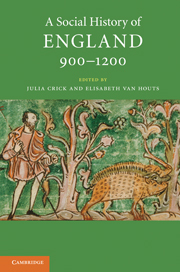Book contents
- Frontmatter
- Contents
- List of figures
- List of maps and tables
- List of contributors
- Acknowledgements
- List of abbreviations
- Map 1 England and its neighbours
- Map 2 England 900–1200
- I Introduction
- I.1 Land use and people
- I.2 Water and land
- I.3 Forest and upland
- I.4 Mineral resources
- I.5 Health and disease
- II.1 Authority and community
- II.2 Lordship and labour
- II.3 Order and justice
- II.4 War and violence
- II.5 Family, marriage, kinship
- II.6 Poor and powerless
- III.1 Towns and their hinterlands
- III.2 Commerce and markets
- III.3 Urban planning
- III.4 Urban populations and associations
- IV.1 Invasion and migration
- IV.2 Ethnicity and acculturation
- IV.3 Intermarriage
- IV.4 The Jews
- V.1 Religion and belief
- V.2 Rites of passage and pastoral care
- V.3 Saints and cults
- V.4 Public spectacle
- V.5 Textual communities (Latin)
- V.6 Textual communities (vernacular)
- VI.1 Learning and training
- VI.2 Information and its retrieval
- VI.3 Esoteric knowledge
- VI.4 Medical practice and theory
- VI.5 Subversion
- Glossary
- Time line 900–1200
- Further reading
- Index
I.3 - Forest and upland
Published online by Cambridge University Press: 05 June 2012
- Frontmatter
- Contents
- List of figures
- List of maps and tables
- List of contributors
- Acknowledgements
- List of abbreviations
- Map 1 England and its neighbours
- Map 2 England 900–1200
- I Introduction
- I.1 Land use and people
- I.2 Water and land
- I.3 Forest and upland
- I.4 Mineral resources
- I.5 Health and disease
- II.1 Authority and community
- II.2 Lordship and labour
- II.3 Order and justice
- II.4 War and violence
- II.5 Family, marriage, kinship
- II.6 Poor and powerless
- III.1 Towns and their hinterlands
- III.2 Commerce and markets
- III.3 Urban planning
- III.4 Urban populations and associations
- IV.1 Invasion and migration
- IV.2 Ethnicity and acculturation
- IV.3 Intermarriage
- IV.4 The Jews
- V.1 Religion and belief
- V.2 Rites of passage and pastoral care
- V.3 Saints and cults
- V.4 Public spectacle
- V.5 Textual communities (Latin)
- V.6 Textual communities (vernacular)
- VI.1 Learning and training
- VI.2 Information and its retrieval
- VI.3 Esoteric knowledge
- VI.4 Medical practice and theory
- VI.5 Subversion
- Glossary
- Time line 900–1200
- Further reading
- Index
Summary
WOODLAND
Anglo-Saxon England was not a very wooded country. The original prehistoric wildwood had long since gone, and woods had been interacting with people for thousands of years. Only about half of the 13,000 estates recorded in Domesday Book possessed woodland; the area adds up to about 15 per cent of England, much more than there is now, but less than France has now. About one in thirty of the boundary features mentioned in Anglo-Saxon perambulations alludes to a wood: these are located in roughly the same areas where Domesday records woodland. Woodland can also be inferred from place-names, which, however, are difficult to date. Generally place-names indicate that the distribution of wooded and non-wooded areas, as recorded in perambulations and Domesday, was already established well before 900.
England in the period from 900 to 1200 lacked many species of tree familiar today: sycamore, horse-chestnut, most poplars and all conifers except yew and juniper. Beech and sweet-chestnut were much less widespread than now. Plantations (people planting areas of trees) begin after our period. There were, however, trees in hedges and other non-woodland places, as recorded in many boundary perambulations, and also orchards.
Woodland was very unevenly distributed. There were big concentrations in the Weald and the Chiltern plateau, and lesser concentrations in Worcestershire, north Warwickshire and east Cheshire; the southern Lake District, though outside the scope of Domesday Book, had abundant woodland as recorded in place-names.
- Type
- Chapter
- Information
- A Social History of England, 900–1200 , pp. 46 - 55Publisher: Cambridge University PressPrint publication year: 2011

